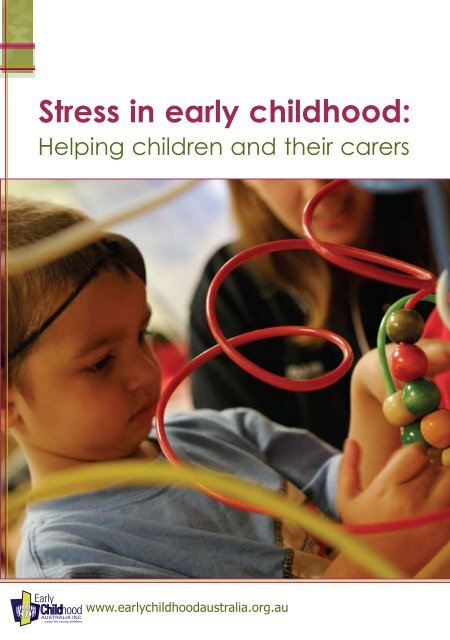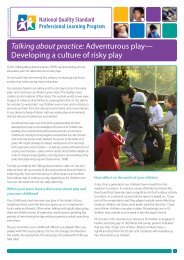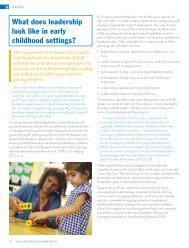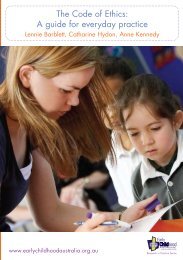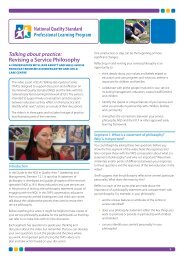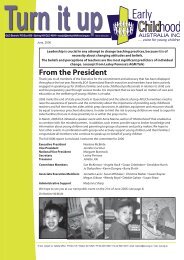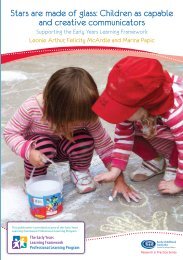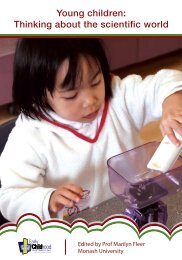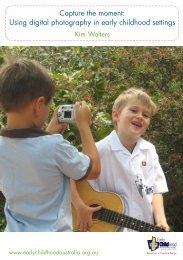Stress in early childhood: Helping children and their carers
Stress in early childhood: Helping children and their carers
Stress in early childhood: Helping children and their carers
You also want an ePaper? Increase the reach of your titles
YUMPU automatically turns print PDFs into web optimized ePapers that Google loves.
<strong>Stress</strong> <strong>in</strong> <strong>early</strong> <strong>childhood</strong>:<br />
Help<strong>in</strong>g <strong>children</strong> <strong>and</strong> <strong>their</strong> <strong>carers</strong><br />
www.<strong>early</strong><strong>childhood</strong>australia.org.au
About Early Childhood Australia<br />
Early Childhood Australia, formerly the<br />
Australian Early Childhood Association, actively<br />
promotes the provision of high quality services<br />
for all young <strong>children</strong> from birth to eight years<br />
<strong>and</strong> <strong>their</strong> families, <strong>and</strong> supports the important<br />
role of parents. Early Childhood Australia is also<br />
the national umbrella organisation for <strong>children</strong>’s<br />
services <strong>and</strong> a lead<strong>in</strong>g <strong>early</strong> <strong>childhood</strong> publisher.<br />
Membership, subscription<br />
& advertis<strong>in</strong>g <strong>in</strong>quiries:<br />
Early Childhood Australia Inc.<br />
PO Box 7105 Watson ACT 2602<br />
Tel: 02 6242 1800<br />
Fax: 02 6242 1818<br />
Sales l<strong>in</strong>e (toll free): 1800 356 900<br />
Email: eca@<strong>early</strong><strong>childhood</strong>.org.au<br />
Edition Editor<br />
Alison Elliott<br />
Series Editor<br />
Sue Wales<br />
Publish<strong>in</strong>g & Market<strong>in</strong>g<br />
David K<strong>in</strong>gwell<br />
Alana van Meurs<br />
Graphic Design<br />
Claire Connelly<br />
Cover Photograph<br />
Andrew Sikorski<br />
Photos<br />
A. Sikorski<br />
Patrice Thomas<br />
© Copyright 2006<br />
All rights reserved by<br />
Early Childhood Australia Inc.<br />
Material here<strong>in</strong> must not be reproduced<br />
<strong>in</strong> any form without the written permission<br />
of Early Childhood Australia Inc.<br />
ISBN 1-921162-00-7<br />
Pr<strong>in</strong>ted by Paragon Pr<strong>in</strong>ters, Canberra<br />
About the author<br />
Patrice Thomas has been an <strong>early</strong> <strong>childhood</strong>/<br />
special education teacher <strong>and</strong> university<br />
lecturer for over 20 years. She is the<br />
author of The Magic of Relaxation (2002)<br />
Pademelon Press, Sydney <strong>and</strong> The Power of<br />
Relaxation (2003) Redleaf Press, M<strong>in</strong>nesota,<br />
<strong>and</strong> has also written articles for a range of<br />
publications such as Every Child; Child Care<br />
Information Exchange; Reflections (Gowrie<br />
RAP); Childcare <strong>and</strong> Children’s Health;<br />
<strong>and</strong> Journal of Early Childhood Teacher<br />
Education.<br />
Patrice is a consultant to <strong>early</strong> <strong>childhood</strong>,<br />
education, health <strong>and</strong> corporate groups.<br />
She presents workshops <strong>and</strong> tra<strong>in</strong><strong>in</strong>g<br />
sem<strong>in</strong>ars on <strong>Stress</strong> Management;<br />
Communication Skills; Conflict<br />
Management; Relaxation for Children <strong>and</strong><br />
Spirituality <strong>in</strong> Young Children’s Lives. Patrice<br />
is also <strong>in</strong>vited to speak at various cancer<br />
support groups <strong>and</strong> she has developed two<br />
CDs to accompany her relaxation techniques<br />
<strong>and</strong> exercises, both of which are available<br />
from www.newworldmusic.com.au<br />
Patrice is passionate about help<strong>in</strong>g adults<br />
<strong>and</strong> <strong>children</strong> to develop wellbe<strong>in</strong>g <strong>and</strong><br />
health through techniques that are holistic<br />
<strong>and</strong> simple to use <strong>in</strong> childcare, school,<br />
work or home environments. She can be<br />
contacted on (02) 4784 2904 or email:<br />
patrice.thomas@bigpond.com
Contents<br />
Introduction 2<br />
What is stress? 2<br />
What is the stress response? 2<br />
<strong>Stress</strong> <strong>and</strong> <strong>children</strong> 4<br />
What are some of the causes of stress for young <strong>children</strong>? 5<br />
How do <strong>children</strong> experience stress? 7<br />
The long-term effects of stress 8<br />
The spiritual child 9<br />
Transform<strong>in</strong>g education through relaxation <strong>and</strong> reflection with <strong>children</strong> 10<br />
Educat<strong>in</strong>g <strong>children</strong> for the 21st Century 11<br />
The courage to transform 12<br />
Mak<strong>in</strong>g relaxation contagious 12<br />
Relaxation for <strong>children</strong> with special needs 17<br />
<strong>Stress</strong> <strong>in</strong> <strong>carers</strong> of young <strong>children</strong> 19<br />
Develop<strong>in</strong>g a balance <strong>in</strong> life 19<br />
<strong>Stress</strong> is a problem for organisations 22<br />
Signs <strong>and</strong> symptoms of stress <strong>in</strong> <strong>early</strong> <strong>childhood</strong> practitioners 23<br />
Unproductive habits 24<br />
Relaxation is the opposite of stress 25<br />
Develop<strong>in</strong>g a stress management plan 26<br />
Communication skills 28<br />
Time management 30<br />
The environment 31<br />
Breath<strong>in</strong>g techniques 33<br />
Exercise 33<br />
Relaxation 34<br />
Personal empowerment practices 35<br />
Tips for crises <strong>and</strong> the unexpected <strong>in</strong> the <strong>early</strong> <strong>childhood</strong> day 36<br />
References 38<br />
<strong>Stress</strong> <strong>in</strong> <strong>early</strong> <strong>childhood</strong>: Help<strong>in</strong>g <strong>children</strong> <strong>and</strong> <strong>their</strong> <strong>carers</strong> 1
Introduction<br />
What is stress?<br />
<strong>Stress</strong> is a complex phenomenon. It has different mean<strong>in</strong>gs to different people <strong>and</strong> can be<br />
very subjective. What is stressful for one person might not be stressful for the next. It depends<br />
largely on background experiences, temperament <strong>and</strong> environmental conditions.<br />
<strong>Stress</strong> has been def<strong>in</strong>ed variously as:<br />
’ … the non-specific response of the body to any dem<strong>and</strong> that exceeds the person’s ability<br />
to cope; as a person–environment relationship that threatens or taxes personal resources,<br />
<strong>and</strong> as a mental state <strong>in</strong> response to stra<strong>in</strong>s or daily hassles.’ (Mann<strong>in</strong>g <strong>and</strong> Curtis, 1988;<br />
Allen, 1992.)<br />
Occupational stress stems from conditions <strong>in</strong> the workplace. These conditions may either cause<br />
stress <strong>in</strong>itially or aggravate the stress already present from other sources (Dillenburger, 2004).<br />
Eustress <strong>and</strong> distress<br />
Many people use the terms stress <strong>and</strong> distress as though they are <strong>in</strong>terchangeable. The<br />
common view is that stress is someth<strong>in</strong>g bad. Hans Seyle, the ’father‘ of stress management,<br />
<strong>in</strong>troduced the terms distress <strong>and</strong> eustress. Accord<strong>in</strong>g to Selye (1976), distress is ’damag<strong>in</strong>g<br />
or unpleasant stress‘ (p. 31), where the core response is negative, pa<strong>in</strong>ful <strong>and</strong> someth<strong>in</strong>g<br />
to be avoided. Eustress describes a positive view of stress or a challenge—someth<strong>in</strong>g to be<br />
sought out <strong>and</strong> used as an ally for personal <strong>and</strong> professional growth. Examples of eustress<br />
are anticipation of a holiday or the arousal needed to create a work of art. Eustress heightens<br />
awareness, <strong>in</strong>creases mental alertness, <strong>and</strong> can lead to superior cognitive <strong>and</strong> behavioural<br />
performance (Rice, 1999).<br />
The education <strong>and</strong> child care fields are not immune from this<br />
phenomenon. <strong>Stress</strong> is associated with problems of recruitment, health<br />
<strong>and</strong> retention of <strong>early</strong> <strong>childhood</strong> staff. Jarvis (2002) believes there are<br />
gaps <strong>in</strong> our underst<strong>and</strong><strong>in</strong>g of teacher stress, most notably regard<strong>in</strong>g<br />
effective <strong>in</strong>terventions. This book aims to offer some practical <strong>and</strong><br />
effective strategies for stress management <strong>in</strong> <strong>early</strong> <strong>childhood</strong> staff <strong>and</strong><br />
the <strong>children</strong> <strong>in</strong> <strong>their</strong> care.<br />
‘The body’s aim is to come<br />
back to a state of balance<br />
(homeostasis) after be<strong>in</strong>g<br />
stressed. This return to<br />
stability <strong>and</strong> balance is<br />
important for ma<strong>in</strong>ta<strong>in</strong><strong>in</strong>g<br />
health <strong>and</strong> wellbe<strong>in</strong>g.’<br />
What is the stress response?<br />
Accord<strong>in</strong>g to Montgomery <strong>and</strong> Evans (1995), the stress response is a state of arousal consist<strong>in</strong>g<br />
of a number of bodily changes that present as feel<strong>in</strong>gs of be<strong>in</strong>g stressed. It also refers to the<br />
energy levels required for tackl<strong>in</strong>g the stressful situation.<br />
The body’s aim is to come back to a state of balance (homeostasis) after be<strong>in</strong>g stressed.<br />
This return to stability <strong>and</strong> balance is important for ma<strong>in</strong>ta<strong>in</strong><strong>in</strong>g health <strong>and</strong> wellbe<strong>in</strong>g.<br />
In extreme cases, this response is described as ’fight or flight’—see opposite. However, the<br />
response occurs so often <strong>in</strong> its mild form that it often passes unnoticed.<br />
2 <strong>Stress</strong> <strong>in</strong> <strong>early</strong> <strong>childhood</strong>: Help<strong>in</strong>g <strong>children</strong> <strong>and</strong> <strong>their</strong> <strong>carers</strong>
<strong>Stress</strong> becomes a problem when stress reactions are so severe, occur frequently or over a long<br />
period of time that the person is unable to h<strong>and</strong>le them effectively. <strong>Stress</strong> also becomes a<br />
problem when a person constantly has feel<strong>in</strong>gs of be<strong>in</strong>g over-stretched, fatigued, hav<strong>in</strong>g poor<br />
judgement, <strong>and</strong> achiev<strong>in</strong>g little <strong>in</strong> relation to the effort <strong>in</strong>volved. As a consequence, the person<br />
is more susceptible to illness because the body’s resistance to disease decreases under stress.<br />
Cannon (1932) was the first writer to propose the ’fight or flight‘ response, mean<strong>in</strong>g that when<br />
a person is stressed, the body is rapidly aroused <strong>and</strong> motivated by the sympathetic nervous<br />
system. The ’fight or flight’ response prepares the body for action. The muscles tense, the heart<br />
rate escalates, thought becomes rapid, perspiration <strong>in</strong>creases <strong>and</strong> breath<strong>in</strong>g quickens. The body<br />
is ready to fight or run from the perceived threat. Back through the ages, this response was<br />
necessary for survival (the ‘survival of the fittest’); for example, when the threat was physical<br />
danger, such as confrontation with a large, hungry animal.<br />
What happens to the body when it enters the ‘fight or flight’ state?<br />
• Breath<strong>in</strong>g becomes shallow <strong>and</strong> rapid.<br />
• The heartbeat <strong>in</strong>creases.<br />
• Blood pressure rises.<br />
• Adrenal<strong>in</strong>e <strong>and</strong> other hormones are released <strong>in</strong>to the blood.<br />
• The senses are heightened.<br />
• The liver releases stored sugar <strong>in</strong>to the blood.<br />
• Muscles tense <strong>and</strong> tighten.<br />
• Blood flow <strong>in</strong>creases to the bra<strong>in</strong> <strong>and</strong> major muscles <strong>and</strong> is<br />
constricted to the extremities.<br />
In contemporary times, the more probable causes of stress<br />
are related to relationships, f<strong>in</strong>ancial worries <strong>and</strong> performance<br />
anxieties. In our society it is not often necessary to fight to<br />
save our lives, but we still respond the same way to danger,<br />
whether real or imag<strong>in</strong>ed. This physiological response is no<br />
longer appropriate for the types of stress we commonly<br />
experience, but it comes <strong>in</strong>to play whenever our stress levels<br />
<strong>in</strong>crease. We can get <strong>in</strong>to a state where the stress response is<br />
operat<strong>in</strong>g all the time. This can result <strong>in</strong> repression of storedup<br />
energy or <strong>in</strong>appropriate release of it, often <strong>in</strong> negative<br />
or destructive ways. These can <strong>in</strong>clude reliance on alcohol,<br />
excessive eat<strong>in</strong>g, smok<strong>in</strong>g <strong>and</strong> other drug abuse.<br />
Other typical <strong>and</strong> harmful stress release responses are anger,<br />
emotional <strong>and</strong> psychological withdrawal, <strong>and</strong> depression. The<br />
danger lies <strong>in</strong> the stress reaction itself <strong>and</strong> how we choose to<br />
release or repress our stored-up energy.<br />
<strong>Stress</strong> <strong>in</strong> <strong>early</strong> <strong>childhood</strong>: Help<strong>in</strong>g <strong>children</strong> <strong>and</strong> <strong>their</strong> <strong>carers</strong> 3
<strong>Stress</strong> <strong>and</strong> <strong>children</strong><br />
If there is light <strong>in</strong> the soul, there is beauty <strong>in</strong> the person,<br />
If there is beauty <strong>in</strong> the person, there will be harmony <strong>in</strong> the house,<br />
If there is harmony <strong>in</strong> the house, there will be order <strong>in</strong> the nation,<br />
If there is order <strong>in</strong> the nation, there will be peace <strong>in</strong> the world.<br />
Anonymous<br />
In recent years, changes <strong>in</strong> <strong>childhood</strong>, family life <strong>and</strong> culture have caused <strong>early</strong> <strong>childhood</strong><br />
professionals to seek new approaches to manag<strong>in</strong>g the stresses experienced by young <strong>children</strong>.<br />
It is possible to teach <strong>children</strong> proactive ways to manage stress from an <strong>early</strong> age. They can ga<strong>in</strong><br />
more personal control <strong>in</strong> <strong>their</strong> lives when they learn to relax, focus <strong>and</strong> de-stress.<br />
Many professionals are worried that the task of grow<strong>in</strong>g up <strong>in</strong> today’s stressful world is gett<strong>in</strong>g<br />
tougher. Although not all <strong>children</strong> are experienc<strong>in</strong>g difficulty, <strong>in</strong>creas<strong>in</strong>g numbers apparently<br />
have fewer sources of adult support, affirmation <strong>and</strong> love than <strong>in</strong> the recent past. Many<br />
<strong>children</strong> are be<strong>in</strong>g pressured to grow up faster (Elk<strong>in</strong>d, 1988; Kostelnik et al., 1998).<br />
Childhood stresses are many <strong>and</strong> varied. These can<br />
range from day-to-day upsets about be<strong>in</strong>g teased ‘Many professionals are worried that<br />
by others or fight<strong>in</strong>g over toys, to the damag<strong>in</strong>g the task of grow<strong>in</strong>g up <strong>in</strong> today’s<br />
experience of be<strong>in</strong>g physically <strong>and</strong> sexually abused. stressful world is gett<strong>in</strong>g tougher.’<br />
There are societal concerns about the grow<strong>in</strong>g<br />
numbers of chronically unhappy, hyperactive, or lethargic <strong>and</strong> unmotivated <strong>children</strong> now<br />
be<strong>in</strong>g seen by cl<strong>in</strong>icians. If these youngsters’ problems are not addressed, they may be <strong>in</strong>cl<strong>in</strong>ed<br />
towards school failure, psychosomatic problems, <strong>and</strong> <strong>early</strong> <strong>in</strong>volvement <strong>in</strong> antisocial behaviour<br />
<strong>and</strong> substance abuse. Such <strong>children</strong> have been described as the ’unwill<strong>in</strong>g, un<strong>in</strong>tended victims<br />
of overwhelm<strong>in</strong>g stress … borne of rapid, bewilder<strong>in</strong>g social change <strong>and</strong> constantly ris<strong>in</strong>g<br />
expectations‘ (Elk<strong>in</strong>d, cited <strong>in</strong> Kostelnik et al., 1998).<br />
The research literature tends to highlight the impact of s<strong>in</strong>gle-variable stressors on <strong>children</strong>’s<br />
development. However, <strong>in</strong> real life, everyday situations, such as out-of-home care <strong>and</strong> school,<br />
<strong>children</strong> experience stress from multiple sources. Multiple stressors <strong>in</strong>teract with one another<br />
<strong>and</strong> can have cumulative effects.<br />
Furman (1995) believes that stresses affect<strong>in</strong>g <strong>children</strong> should not be avoided when they or<br />
<strong>their</strong> derivatives imp<strong>in</strong>ge on the classroom—he believes they may offer optimal opportunities<br />
for effective <strong>early</strong> <strong>childhood</strong> education.<br />
’ … deal<strong>in</strong>g effectively with stresses as well as with feel<strong>in</strong>gs, requires a cooperative<br />
relationship between the child’s teachers <strong>and</strong> particularly between the teacher <strong>and</strong> the<br />
primary mother<strong>in</strong>g person’ (p. 33).<br />
When child care professionals <strong>and</strong> families work collaboratively, <strong>children</strong> can become more<br />
resilient by learn<strong>in</strong>g to recognise <strong>and</strong> manage stress <strong>in</strong> <strong>their</strong> lives.<br />
4 <strong>Stress</strong> <strong>in</strong> <strong>early</strong> <strong>childhood</strong>: Help<strong>in</strong>g <strong>children</strong> <strong>and</strong> <strong>their</strong> <strong>carers</strong>
What are some of the causes of stress for young <strong>children</strong>?<br />
Figures from the Australian Bureau of Statistics (ABS, 2002) reveal marked <strong>in</strong>creases <strong>in</strong> the<br />
numbers of <strong>children</strong> receiv<strong>in</strong>g child care—both formal <strong>and</strong> <strong>in</strong>formal. Other recent social trends<br />
<strong>in</strong>dicate that people are work<strong>in</strong>g longer hours (often as unpaid overtime) <strong>and</strong> that <strong>in</strong>creas<strong>in</strong>g<br />
numbers of households are experienc<strong>in</strong>g f<strong>in</strong>ancial stress. Additionally, one <strong>in</strong> four <strong>children</strong> does<br />
not live with both <strong>their</strong> natural parents (ABS, 2002). Along with a significant proportion of the<br />
population (one <strong>in</strong> four) experienc<strong>in</strong>g some form of mental illness, are the common disorders<br />
of anxiety, substance abuse <strong>and</strong> depression (ABS, 2002), which impact negatively on young<br />
<strong>children</strong>.<br />
Australia has one of the highest rates of youth suicide <strong>in</strong> the world, <strong>and</strong> alcohol <strong>and</strong> drug<br />
disorders are <strong>in</strong>creas<strong>in</strong>g <strong>in</strong> young people. The activity levels of Australians are decreas<strong>in</strong>g.<br />
Fewer <strong>and</strong> fewer Australians are participat<strong>in</strong>g <strong>in</strong> physical activities <strong>and</strong> sports, <strong>and</strong> more are<br />
experienc<strong>in</strong>g the stress-related problems of a sedentary lifestyle. This is also lead<strong>in</strong>g to <strong>in</strong>creased<br />
obesity levels <strong>in</strong> <strong>children</strong> <strong>and</strong> adults. Additionally, the ‘24/7’ economy has permeated our<br />
lifestyles, where work can <strong>in</strong>trude anywhere <strong>and</strong> everywhere. Many workers are described as<br />
be<strong>in</strong>g perpetually attached to work via a digital ’leash’—pagers, mobile phones, palm devices<br />
<strong>and</strong> laptops. These factors impact upon adults <strong>and</strong> <strong>children</strong> alike (Thomas, 2003).<br />
As a result of our liv<strong>in</strong>g complex <strong>and</strong> fast-paced lives (Kostelnik et al., 1998), <strong>and</strong> as <strong>children</strong>’s<br />
<strong>in</strong>teractions broaden beyond the family, the child’s world becomes potentially more stressful.<br />
There is a wide range of causes of stress for young <strong>children</strong> (stressors). These <strong>in</strong>clude some<br />
<strong>children</strong>’s personalities <strong>and</strong> temperaments. For example, some <strong>children</strong> never feel comfortable<br />
or happy <strong>in</strong> any sett<strong>in</strong>g, no matter how <strong>in</strong>clusive <strong>and</strong> diverse the program offered. Some<br />
<strong>children</strong> have difficulty gett<strong>in</strong>g along with <strong>their</strong> parents, peers, sibl<strong>in</strong>gs <strong>and</strong> people <strong>in</strong> general.<br />
Kostelnik et al. <strong>and</strong> Miller (1996) describe a range of stressors experienced by <strong>children</strong>:<br />
‘Family life, which often serves as a buffer for <strong>children</strong>, also can be a source of stress for<br />
them. The ord<strong>in</strong>ary aspects of family life may pile up to create dem<strong>and</strong>s for <strong>children</strong> that<br />
range from mildly stressful to overwhelm<strong>in</strong>g. The birth of a sibl<strong>in</strong>g, the death of a pet,<br />
break<strong>in</strong>g a favourite toy, gett<strong>in</strong>g caught steal<strong>in</strong>g or ly<strong>in</strong>g, carelessly spill<strong>in</strong>g milk, los<strong>in</strong>g<br />
a gr<strong>and</strong>parent, or br<strong>in</strong>g<strong>in</strong>g home a bad report card all can be either opportunities for<br />
growth or highly negative experiences, depend<strong>in</strong>g on the responses of significant adults.’<br />
(Kostelnik et al., 1998, p. 135)<br />
Family stressors <strong>in</strong>clude factors such as:<br />
• separation <strong>and</strong> divorce of parents<br />
• s<strong>in</strong>gle-parent families<br />
• blended families<br />
• death<br />
• work<strong>in</strong>g parents<br />
• <strong>children</strong> <strong>in</strong> abusive or neglectful<br />
families <strong>and</strong><br />
• <strong>children</strong> <strong>in</strong> foster care.<br />
<strong>Stress</strong> <strong>in</strong> <strong>early</strong> <strong>childhood</strong>: Help<strong>in</strong>g <strong>children</strong> <strong>and</strong> <strong>their</strong> <strong>carers</strong> 5
Environmental stressors <strong>in</strong>clude:<br />
• poor-quality child care<br />
• stress <strong>in</strong> formal school sett<strong>in</strong>gs<br />
• cultural isolation<br />
• stress <strong>and</strong> trauma as a result of flee<strong>in</strong>g<br />
from <strong>their</strong> homes, travell<strong>in</strong>g to a<br />
new country, wait<strong>in</strong>g for applications<br />
for refugee status to be approved<br />
(often <strong>in</strong> detention centres) <strong>and</strong><br />
adapt<strong>in</strong>g to a new country<br />
• health-related assaults, illness or<br />
hospitalisation<br />
• disability<br />
• learn<strong>in</strong>g difficulties<br />
• the death of a pet<br />
• a new baby <strong>in</strong> the family<br />
• start<strong>in</strong>g school<br />
• bully<strong>in</strong>g or teas<strong>in</strong>g at school<br />
• spend<strong>in</strong>g time with a number of<br />
caregivers<br />
• long hours <strong>in</strong> care <strong>and</strong> after-school<br />
sett<strong>in</strong>gs<br />
• natural disasters<br />
• war, terrorism <strong>and</strong> violence.<br />
Greenman (2002) believes that crises can br<strong>in</strong>g out the best <strong>and</strong> worst <strong>in</strong> all of us, but it is the<br />
adults’ role to guide <strong>children</strong> towards thoughtfulness, car<strong>in</strong>g, k<strong>in</strong>dness <strong>and</strong> courage.<br />
Push<strong>in</strong>g <strong>children</strong> to achieve too much at an <strong>early</strong> age can cause them to burn out. Some<br />
parents are so keen for <strong>their</strong> <strong>children</strong> to live up to <strong>their</strong> potential that they expect them to<br />
be busy <strong>and</strong> occupied n<strong>early</strong> every wak<strong>in</strong>g moment. Elk<strong>in</strong>d (1988) refers to this as ’forced<br />
bloom<strong>in</strong>g’ <strong>and</strong> highlights the usurp<strong>in</strong>g of important play experiences for <strong>children</strong> by adultdirected<br />
extra-curricular activities. This rapid-paced, high-geared, fast-food<br />
society is often referred to as ’socially toxic’. Furthermore, many of the markers ‘Push<strong>in</strong>g <strong>children</strong><br />
that <strong>in</strong>dicated the passage from <strong>childhood</strong> to adulthood are becom<strong>in</strong>g blurred, to achieve too<br />
as <strong>children</strong> are <strong>in</strong>creas<strong>in</strong>gly encouraged to copy adult dress, aspirations <strong>and</strong> much at an <strong>early</strong><br />
behaviour (for example, becom<strong>in</strong>g little ‘stars’ or age can cause<br />
models <strong>and</strong> be<strong>in</strong>g exposed to <strong>in</strong>appropriate images them to burn out.’<br />
<strong>and</strong> <strong>in</strong>teractions on the Internet, X-box games <strong>and</strong><br />
television <strong>and</strong> movies). It is not surpris<strong>in</strong>g that, <strong>in</strong> our society, most<br />
<strong>children</strong> conclude that the status of personhood is atta<strong>in</strong>ed by<br />
becom<strong>in</strong>g a consumer.<br />
The message from the marketplace to <strong>children</strong> is ’I buy, therefore I<br />
am.’<br />
Success at school <strong>and</strong> <strong>in</strong> other activities is important <strong>and</strong> worthwhile,<br />
but not at the expense of <strong>children</strong>’s wellbe<strong>in</strong>g <strong>and</strong> happ<strong>in</strong>ess.<br />
Children’s responses to stress vary accord<strong>in</strong>g to the <strong>in</strong>dividual child’s<br />
temperament <strong>and</strong> personality, the child’s developmental level <strong>and</strong> the<br />
child’s previous life experience. Manag<strong>in</strong>g stress appears to be highly<br />
dependent on a child’s developmental capabilities <strong>and</strong> cop<strong>in</strong>g skills.<br />
6 <strong>Stress</strong> <strong>in</strong> <strong>early</strong> <strong>childhood</strong>: Help<strong>in</strong>g <strong>children</strong> <strong>and</strong> <strong>their</strong> <strong>carers</strong>
How do <strong>children</strong> experience stress?<br />
There are two ma<strong>in</strong> categories of stressful experiences:<br />
• Acute stress is a sudden <strong>in</strong>tense onset of the stressful situation (e.g. a car accident).<br />
• Chronic stress (e.g. the loss of a loved one) is ongo<strong>in</strong>g <strong>and</strong>, accord<strong>in</strong>g to Gunnar<br />
<strong>and</strong> Barr (1998), the most significant <strong>and</strong> detrimental for <strong>children</strong>. The effects <strong>in</strong>clude<br />
chang<strong>in</strong>g bra<strong>in</strong> chemistry <strong>and</strong> function, <strong>and</strong> a lower<strong>in</strong>g of resistance to disease.<br />
In <strong>early</strong> <strong>childhood</strong>, we need to address the above concerns about stress <strong>in</strong> effective <strong>and</strong> creative<br />
ways so that <strong>carers</strong> of <strong>children</strong> <strong>and</strong> <strong>children</strong> themselves can learn about <strong>and</strong> practise stress<br />
management techniques that are holistic—work<strong>in</strong>g on the body, m<strong>in</strong>d, emotions <strong>and</strong> spirit.<br />
Teachers, child care workers <strong>and</strong> parents all need to f<strong>in</strong>d a balance between encourag<strong>in</strong>g<br />
<strong>children</strong> to experience success <strong>in</strong> life <strong>and</strong> encourag<strong>in</strong>g them just to be <strong>children</strong>. Positive<br />
practices undertaken daily <strong>in</strong> child care <strong>and</strong> education sett<strong>in</strong>gs can create a real difference <strong>in</strong><br />
<strong>children</strong>’s lives. Additionally, the <strong>carers</strong>, teachers <strong>and</strong> parents can work together <strong>and</strong> ga<strong>in</strong> the<br />
benefits of holistic stress management techniques along with the <strong>children</strong> <strong>in</strong> <strong>their</strong> care.<br />
Children’s responses to stress<br />
Chronic <strong>and</strong> acute stress are likely to have a negative <strong>and</strong><br />
far-reach<strong>in</strong>g impact upon the health, development <strong>and</strong><br />
wellbe<strong>in</strong>g of our <strong>children</strong>. If <strong>children</strong> are confronted with too<br />
many stressful situations, or if the stresses are too severe,<br />
the stra<strong>in</strong> can become too great for them to h<strong>and</strong>le (Rickard,<br />
1996; Pearson, 1998; Greenman, 2002; Thomas, 2003).<br />
<strong>Stress</strong> impacts adversely on <strong>children</strong>’s physical, psychological,<br />
emotional <strong>and</strong> spiritual wellbe<strong>in</strong>g, as well as <strong>their</strong> social skills<br />
<strong>and</strong> <strong>their</strong> ability to concentrate <strong>and</strong> learn (Honig, 1986; Elk<strong>in</strong>d,<br />
1988; Romano, 1992; Youngs, 1995; Thomas, 2003).<br />
‘Teachers, child care<br />
workers <strong>and</strong> parents all<br />
need to f<strong>in</strong>d a balance<br />
between encourag<strong>in</strong>g<br />
<strong>children</strong> to experience<br />
success <strong>in</strong> life <strong>and</strong><br />
encourag<strong>in</strong>g them just to<br />
be <strong>children</strong>.’<br />
Modell<strong>in</strong>g empathy <strong>and</strong> compassion<br />
Early <strong>childhood</strong> practitioners have very little control over the circumstances of <strong>children</strong>’s lives<br />
outside the child care centre or the classroom. We can’t prevent bad th<strong>in</strong>gs from happen<strong>in</strong>g<br />
to <strong>children</strong> or elim<strong>in</strong>ate harmful stressors from <strong>their</strong> lives. But we can look beyond what<br />
we deem as the ‘<strong>in</strong>appropriate’ behaviours <strong>and</strong> the responses <strong>children</strong> sometimes display <strong>in</strong><br />
the classroom, to the real causes of stress <strong>in</strong> <strong>their</strong> lives. We can also model ways of deal<strong>in</strong>g<br />
with stress to the <strong>children</strong> <strong>and</strong> <strong>their</strong> parents <strong>and</strong> exhibit calmness <strong>and</strong> strength <strong>in</strong> the face<br />
of difficulties. In this way we can treat all <strong>children</strong> <strong>and</strong> <strong>their</strong> families with compassion <strong>and</strong><br />
underst<strong>and</strong><strong>in</strong>g <strong>and</strong>, <strong>in</strong> turn, teach them the all-important life skills of learn<strong>in</strong>g to reduce <strong>their</strong><br />
negative responses to stress.<br />
Relaxation skills form an important part of self-cop<strong>in</strong>g skills for <strong>children</strong> <strong>and</strong>, when learned<br />
effectively, can stay with them throughout <strong>their</strong> lives.<br />
Unlike adults, <strong>children</strong> are generally unable to verbalise <strong>their</strong> feel<strong>in</strong>gs, often not hav<strong>in</strong>g the<br />
words to describe <strong>their</strong> fears <strong>and</strong> worries, nor are they able to take positive action towards<br />
manag<strong>in</strong>g stress when it arises.<br />
<strong>Stress</strong> <strong>in</strong> <strong>early</strong> <strong>childhood</strong>: Help<strong>in</strong>g <strong>children</strong> <strong>and</strong> <strong>their</strong> <strong>carers</strong> 7
Children react to stress <strong>and</strong> change <strong>in</strong><br />
many ways, <strong>in</strong>clud<strong>in</strong>g:<br />
➤ defence mechanisms, such as denial,<br />
regression, withdrawal <strong>and</strong> impulsive<br />
act<strong>in</strong>g-out.<br />
These stress responses can allow the<br />
child to temporarily ga<strong>in</strong> a sense of<br />
control or balance. However, these<br />
defence mechanisms are generally not<br />
productive <strong>in</strong> the long term <strong>and</strong> can<br />
lead to more serious stress responses.<br />
These <strong>in</strong>clude:<br />
➤ panic<br />
➤ depression<br />
➤ irritability<br />
➤ distractibility<br />
➤ sleep disturbances <strong>and</strong> bedwett<strong>in</strong>g<br />
➤ self-harm<br />
➤ pull<strong>in</strong>g out <strong>their</strong> hair<br />
➤ temper tantrums<br />
➤ runn<strong>in</strong>g away<br />
➤ defy<strong>in</strong>g significant others<br />
➤ unusual fears or preoccupations with<br />
death<br />
➤ refusal to respond when others talk to<br />
them<br />
➤ refusal to play with <strong>their</strong> peers.<br />
(Kostelnik et al., 1998)<br />
The long-term effects of stress<br />
When <strong>children</strong>’s stress symptoms are not recognised or managed effectively, long-term effects<br />
can be serious <strong>and</strong> may <strong>in</strong>clude behavioural <strong>and</strong> social problems, mental illness, ill health <strong>and</strong><br />
lack of fulfilment, wellbe<strong>in</strong>g, resilience <strong>and</strong> happ<strong>in</strong>ess <strong>in</strong> life.<br />
Raynor <strong>and</strong> Montague (1999, cited <strong>in</strong> Deveson, 2003) reveal some important characteristics of<br />
resilient <strong>children</strong>. These <strong>in</strong>clude:<br />
• emotional <strong>in</strong>telligence—which <strong>in</strong>volves self-esteem <strong>and</strong> confidence<br />
• the ability to create <strong>and</strong> ma<strong>in</strong>ta<strong>in</strong> friendships<br />
• a sense of purpose<br />
• a set of values <strong>and</strong> beliefs<br />
• an <strong>in</strong>ternal locus of control.<br />
Parents, teachers <strong>and</strong> caregivers are concerned about<br />
the effect of stress on the lives of young <strong>children</strong> but<br />
are often at a loss as to how to deal with it (Youngs,<br />
1995). Consequently, there is a risk of ‘b<strong>and</strong>aid’<br />
measures or <strong>in</strong>appropriate ‘quick fix’ practices be<strong>in</strong>g adopted.<br />
‘Develop<strong>in</strong>g resilient <strong>and</strong> happy<br />
<strong>children</strong> is the responsibility of<br />
<strong>early</strong> <strong>childhood</strong> practitioners,<br />
work<strong>in</strong>g <strong>in</strong> partnership with<br />
youngsters <strong>and</strong> <strong>their</strong> families.’<br />
Develop<strong>in</strong>g resilient <strong>and</strong> happy <strong>children</strong> is the responsibility of <strong>early</strong> <strong>childhood</strong> practitioners,<br />
work<strong>in</strong>g <strong>in</strong> partnership with youngsters <strong>and</strong> <strong>their</strong> families. Arm<strong>in</strong>g <strong>children</strong> with a range of<br />
techniques <strong>and</strong> approaches to manage <strong>and</strong> reduce <strong>their</strong> stressful responses enhances <strong>their</strong><br />
ability to learn, relate to others <strong>and</strong> feel good about themselves.<br />
8 <strong>Stress</strong> <strong>in</strong> <strong>early</strong> <strong>childhood</strong>: Help<strong>in</strong>g <strong>children</strong> <strong>and</strong> <strong>their</strong> <strong>carers</strong>
Is stress <strong>in</strong>trud<strong>in</strong>g <strong>in</strong>to your daily activities more frequently?<br />
Is your stress affect<strong>in</strong>g the quality of care you provide?<br />
Do you notice the <strong>children</strong> <strong>in</strong> your care often becom<strong>in</strong>g <strong>in</strong>creas<strong>in</strong>gly<br />
irritable?<br />
<strong>Stress</strong> <strong>in</strong> <strong>early</strong> <strong>childhood</strong>: Help<strong>in</strong>g <strong>children</strong> <strong>and</strong> <strong>their</strong> <strong>carers</strong> offers practical<br />
<strong>and</strong> effective strategies for stress management for both <strong>early</strong> <strong>childhood</strong><br />
staff <strong>and</strong> the <strong>children</strong> <strong>in</strong> <strong>their</strong> care.<br />
Experienced <strong>early</strong> <strong>childhood</strong> practitioner <strong>and</strong> author Patrice Thomas has<br />
written many books <strong>and</strong> articles on stress <strong>and</strong> relaxation. She is sought<br />
after as a presenter for workshops <strong>and</strong> tra<strong>in</strong><strong>in</strong>g sem<strong>in</strong>ars on topics such<br />
as stress management, communication skills, conflict management <strong>and</strong><br />
<strong>children</strong>’s relaxation. Here she offers the benefit of her wisdom, as she<br />
uncovers valuable <strong>in</strong>sights <strong>in</strong>to the causes of stress <strong>and</strong> outl<strong>in</strong>es a range<br />
of activities to counteract it.<br />
Early <strong>childhood</strong> practitioners know that <strong>their</strong>s is both a stressful <strong>and</strong><br />
reward<strong>in</strong>g profession. This is why <strong>Stress</strong> <strong>in</strong> <strong>early</strong> <strong>childhood</strong> is of such great<br />
value to all those <strong>in</strong> the <strong>early</strong> <strong>childhood</strong> field. Reduc<strong>in</strong>g the stress opens up<br />
more opportunities for the positive experiences—for both <strong>children</strong> <strong>and</strong> the<br />
adults who care for them.<br />
Early Childhood Australia Inc.<br />
PO Box 7105 Watson ACT 2602<br />
Tel: 02 6242 1800 Fax: 02 6242 1818<br />
Email: eca@<strong>early</strong><strong>childhood</strong>.org.au<br />
www.<strong>early</strong><strong>childhood</strong>australia.org.au


